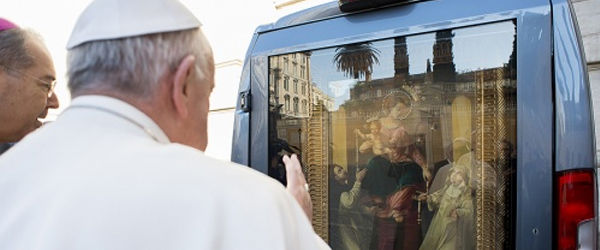The history of the Archdiocese of Los Angeles in California can be traced to the early explorations of Juan Cabrillo in 1542 and Sebastian Vizcaíno in 1602. Accompanying these early explorers were the priests who celebrated Mass in various parts of the area until the actual founding of El Pueblo de Nuestra Se√±ora la Reina de los Angeles in 1781.By that time, Fray Junípero Serra — beginning in 1769 — had founded eight of the 21 California missions, including San Gabriel Arcángel in 1771. It was from San Gabriel that the City of Los Angeles was founded by 44 men, women and children of various ages and assorted ethnicities (half claimed African heritage as descendants of slaves). In 1840 Pope Gregory XVI established a hierarchy in California and appointed Francisco Garcia Diego y Moreno, a native of Jalisco, Mexico, as the first bishop of the gigantic diocese that extended from Oregon to all of Baja California.For 173 years since then, the Catholic Church has flourished and expanded throughout California. Today, there are two metropolitan districts in the state — the Provinces of Los Angeles and San Francisco.The Archdiocese of Los Angeles, the largest in the U.S., has a Catholic population close to five million in three counties — Los Angeles, Ventura and Santa Barbara. Some 300 parishes (including Eastern Catholic) are located in 120 cities in an area encompassing 8,762 square miles. The archdiocese is divided into five Pastoral Regions with an auxiliary bishop in each and four deans serving in each region as a liaison between the priests in the region and the archbishop. Currently 30 different ethnic liturgies are celebrated throughout the archdiocese, with Spanish-language Masses in more than 200 parishes.The men who created dioceses, founded parishes and schools, and fostered the faith by example and virtue, reflect the colorful history of the archdiocese. After Bishop Garcia Diego died in 1846 (he is buried at Santa Barbara Mission), Spanish-born Joseph Sadoc Alemany, a Dominican, was named bishop in 1850 when California became a state. Three years later he became the first archbishop of San Francisco and the Baja peninsula was separated. He established the first school for girls in 1851 under the direction of Dominican Sisters.In 1859, Rome divided California into two dioceses: the Archdiocese of San Francisco and the Diocese of Monterey-Los Angeles. The new bishop was Barcelona-born Thaddeus Amat, Vincentian, who received approval from Rome to move the bishop’s residence from Santa Barbara to Los Angeles. In his 25 years leading the diocese, he erected St. Vibiana Cathedral in 1876. For 18 years Bishop Francisco Mora, another Spaniard from Catalonia, worked tirelessly to establish 72 parishes amid many legal battles against the church. He was succeeded in 1896 by Bishop George Montgomery, the first American head of the diocese (born in Kentucky), who in his seven years faced serious bigotry, but proved himself a great civic leader and dynamic churchman.Two Irish leaders followed. During the term of County Cavan’s Thomas Conaty (1903-15), the diocesan population tripled and numerous schools, hospitals and orphanages were established. John Joseph Cantwell of Limerick, who held the longest term of 30 years (1917-47), created 50 Hispanic parishes and missions.He also saw the local church during not one but two divisions. In 1922, Rome split Monterey-Los Angeles into two dioceses: Los Angeles-San Diego and Monterey-Fresno. And in 1936, Los Angeles was made an archdiocese (and San Diego a diocese), making Cantwell Los Angeles’ first archbishop. Then came Los Angeles’ first two cardinal-archbishops: James Francis McIntyre (1948-70) and Timothy Manning (1970-85). New York-born Cardinal McIntyre added 82 parishes, tripled the number of schools and dealt with a tremendous wave of immigration. Irish-born Cardinal Manning ordained the first permanent deacon class in 1975, a year before the Diocese of Orange was created. In 1985, Pope John Paul II named the first native Angeleno, Roger M. Mahony, to head the largest archdiocese in the country. In 1991 he became Los Angeles’ third cardinal, and in 2002 he dedicated the new Cathedral of Our Lady of the Angels to replace St. Vibiana’s.After 25 years, he was succeeded by Archbishop José Gomez, originally from Monterrey, Mexico, who became Los Angeles’ fifth archbishop March 1, 2011. His motto — Adeamus cum fiducia ad thronum gratiae, from Hebrews 4: 16 (“Let us go forth with confidence to the throne of grace”) — is an appropriate link to the call of Blessed Junípero Serra, founder of the California Missions: Siempre Adelante (“Always forward”).Stories on the founding of Los Angeles, the missions of California and current-day celebrations commemorating those events will appear in the next few weeks of The Tidings.{gallery width=100 height=100}gallery/2013/0823/lahistory/{/gallery}

